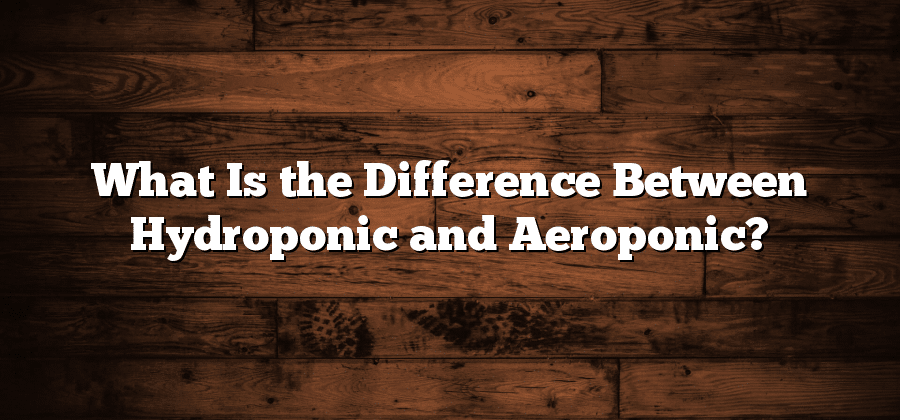I. Introduction
Aeroponics is a modern and innovative method of cultivating plants. Unlike traditional soil-based cultivation methods, aeroponics relies on misting and spraying a nutrient-rich solution directly onto the plant roots. This suspended root system allows for increased oxygen flow, leading to faster growth rates and greater yields.
The concept of aeroponics may sound futuristic, but it has actually been around for several decades. It was first developed by NASA as a means of growing plants in space, and has since been adopted by commercial and home growers alike. The key components of an aeroponic system include a misting system, a reservoir for the nutrient solution, and a support structure to hold the plants in place. With the right setup and careful monitoring, aeroponic cultivation can offer numerous benefits over traditional methods.
Key Components of an Aeroponic System
An aeroponic system consists of several key components that work together to create an optimal environment for plant growth. One of the primary components is the root chamber, where the plant roots are suspended in air and misted with a nutrient-rich solution. This innovative method allows for maximum oxygenation of the roots, leading to faster and healthier growth. Additionally, the root chamber is equipped with a misting system that sprays the nutrient solution at regular intervals to ensure even distribution and uptake by the plants.
Another important component of an aeroponic system is the nutrient delivery system. This system is responsible for providing the plants with the essential nutrients they need to thrive. Typically, it consists of a reservoir that holds the nutrient solution and a pump that delivers the solution to the misting system. The nutrient solution is carefully formulated to include all the necessary minerals and elements needed for plant growth, eliminating the need for soil.
In conclusion, the key components of an aeroponic system work together seamlessly to create an ideal growing environment for plants. By suspending the roots in air and providing a consistent misting of nutrient solution, aeroponics offers a unique and efficient way of cultivating plants. Whether used in large-scale commercial operations or small home gardens, aeroponic systems have the potential to revolutionize the way we grow crops.
Benefits of Aeroponic Cultivation
Aeroponic cultivation offers several key benefits that make it an attractive option for farmers and gardeners. Firstly, it allows plants to receive an ample supply of oxygen, promoting their growth and overall health. By suspending the plant roots in a mist or nutrient-rich solution, aeroponics ensures that the roots have direct access to oxygen, without being limited by soil density or compaction. This oxygen-rich environment stimulates faster and more efficient nutrient uptake, resulting in faster growth rates and higher yields.
Additionally, aeroponics conserves water compared to traditional soil-based cultivation methods. With aeroponics, water is delivered directly to the plant roots through misting or spraying, reducing water waste and allowing for optimal water usage. This is particularly important in regions where water scarcity is a concern. By minimizing water consumption, aeroponics not only saves resources but also helps to decrease the overall environmental impact of agricultural practices.
Limitations of Aeroponic Cultivation
As with any agricultural method, aeroponic cultivation also has its limitations. One major limitation is the high initial cost of setting up an aeroponic system. The equipment required for this method, such as misters, pumps, and sensors, can be expensive. Additionally, the intricate design and complex technology involved in aeroponic systems can make them more prone to breakdowns or failures, requiring regular maintenance and repairs which can add to the overall cost of cultivation.
Another limitation of aeroponic cultivation is its reliance on a continuous and reliable supply of electricity. The misters and pumps used in aeroponic systems require a consistent source of power to maintain the necessary nutrient delivery and oxygenation for plant growth. In areas with unreliable or limited access to electricity, this can pose a significant challenge for farmers looking to adopt aeroponics as their preferred cultivation method.
Despite these limitations, aeroponic cultivation offers numerous benefits that make it an attractive option for growers. It is important for farmers and researchers to continue studying and finding innovative solutions to overcome these limitations and further improve aeroponic systems.
Hydroponic vs. Aeroponic: Similarities and Differences
Hydroponic and aeroponic cultivation are both innovative methods of growing plants without the use of soil. Although they share similar goals, there are fundamental differences in the way these systems operate.
One key distinction lies in the delivery of nutrients to the plants. In hydroponic systems, plants are grown in a nutrient-rich solution that is continually circulated around their roots. This ensures a steady supply of essential minerals and eliminates the need for soil. On the other hand, aeroponic systems use a misting system to deliver nutrients directly to the exposed roots of the plants. This method allows for maximum oxygenation and nutrient absorption, promoting faster and more efficient growth.
Another difference between hydroponic and aeroponic cultivation is the level of complexity involved. Hydroponic systems are generally simpler to set up and maintain, making them more accessible to beginner growers. Aeroponic systems, however, require more precise control of environmental factors such as humidity and misting intervals, making them a better fit for experienced cultivators seeking higher yields and faster growth rates.






